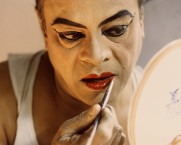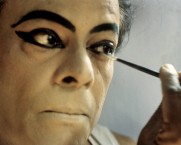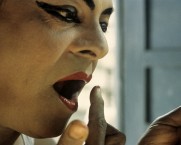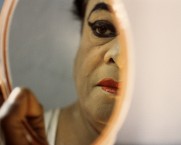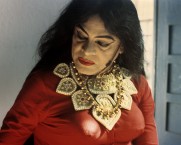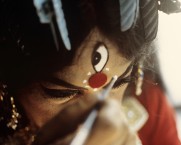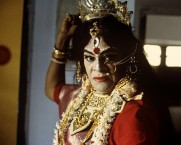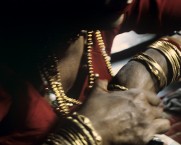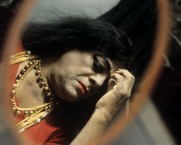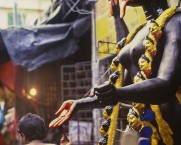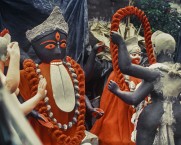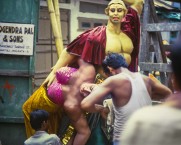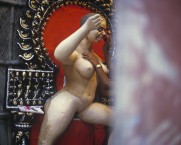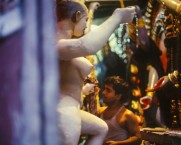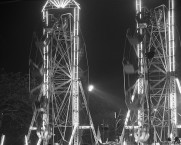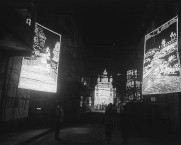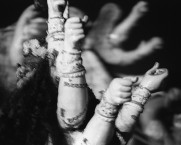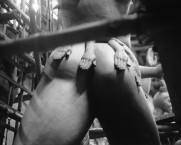C&L Shows
The Green Room
Naveen Kishore
2021
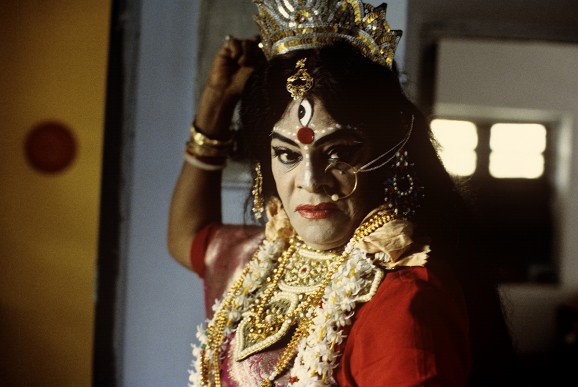
Overview
When is theatre?
When the eye snags. Subversive. And sees what is not ordained. From the margins. From below. Through openings offered, apertures available, for a fleeting moment. Outside, looking in. Outsider, looking on. Revealed: the stories behind the narrative spun for believers, The Grand Show. The tiny moments, the little people, otherwise unseen.
Behind the scenes, backstage. Beyond the borders of Belief, here is no willing suspension of disbelief. Here is the raw, earthy, redolent roil of subtext and back story. Under-story. Grainy textures of decay, gently rotting wood, sweat-soaked spaces of service and toil. This too is kneaded into the flesh of the Grand Show. And disappears, subsumed. If not for the subversive eye. Testimony to an also-reality, too easily unseen.
Transgression. Taboo. A touch, a glance, lips, fingers, eyes. Divinity denied by human hunger. Urgency of the body, stripped bare. Unfiltered, inside-out, unpeeled, revealed to the subversive eye. And once seen, remembered. To be never again unseen.
When is theatre?
Before, after, over, under, beside, alongside, behind, the narrative spun for believers, The Grand Show.
~ Anjum Katyal
The Green Room of the Goddess series, 2003
Kumartuli, a little picture-book setting of tiny lanes in north Kolkata on the banks of the river Hooghly, is almost a village. It is a home and a working space to traditional artisans, potters and artists. In the old days, they used to model river clay into pots. Over time, they gradually started to sculpt and paint idols of gods and goddesses for the traditional Durga, Kali and Saraswati pujas in and around Calcutta.
In 2003, I set out to observe and create images of my own. Photographers from all over the world have made this journey. My only brief to myself was to take photographs that suggested an intimacy that can only come when the subject is unaware of the camera.Using old fashioned analogue Nikon cameras and transparency film, my process was shy, hesitant, almost as if through a keyhole, often not raising the camera viewfinder to my eye, instead preferring to shoot from the waist. Hurriedly attempting to capture the process, the preparation, the backstage activity that goes on each year before that final moment of anointment – when the clay ‘becomes’ goddess to be worshiped across thousands of community pujas across the city.
Four days later she will return to a grand drowning. Awaiting another cycle of rebirth? Maybe.
~ Naveen Kishore | Kolkata | June, 2021
Performing the Goddess series, 1999
‘Now I’m Chapal Rani through and through. No longer Chapal Bhaduri.’
Chapal Bhaduri, alias Chapal Rani or Queen Chapal, leading lady of Bengal’s traditional folk travelling theatre-in-the-round—the jatra—spent his life playing women. Feeling like a woman. Until history changed tradition and women began to play female roles themselves. Out of work, ageing, he turned to a new livelihood: that of playing Sitala, the poor person’s dreaded goddess of pox and disease, in dramatized performances of the goddess’s sacred saga.
This intimate video biography brings you face to face with a unique individual, reminiscing about the world of the Jatra, discussing what it means to become a woman night after night, talking for the first time of the woman inside his male body, of troubled sexuality, of a long domestic partnership with his older lover, of the essential loneliness of living as a human being on the edges of conventional society—and showing how he metamorphoses into the goddess in order to perform her story.
In-depth interviews, extracts from milestone fragments of Jatra plays, the make-up process that metamorphoses a man into a woman into a goddess, and documentation of the play on the goddess, provide you with a rare entry into an unusual world, and a close look at Chapal Bhaduri’s life and work.
‘Performing the Goddess’ has an illustrious international exhibition history and is also included in the collection the Smithsonian’s National Museum of Asian Art, Washington.
A Video Walkthrough by Naveen Kishore accompanied by Mortimer Chatterjee

